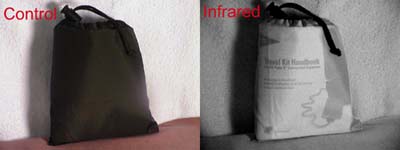
about | articles | authors | contact | links
 about | articles | authors | contact | links |
![]() Home > Articles > Infrared Photography > Reflected infrared photography: Other considerations
Home > Articles > Infrared Photography > Reflected infrared photography: Other considerations
INFRARED PHOTOGRAPHYAuthors: Prof. Robin Williams and Gigi Williams Reflected infrared photography:
|
 |
Figure 47 (left). Many materials transmit infrared freely despite their appearance in visible light this includes some plastics used for the manufacture of darkslides and camera bellows. |

Figure 48 (above). The black material that this bag is made of is quite black in normal light (left) but almost transparent to infrared (right) - notice how clearly the writing can be read through the bag. This has been described, quite erroneously, as an 'x-ray effect.' Images © MaxMax.
Not all cameras are suited for infrared use - even if their construction is infrared opaque. Some modern cameras, for example, use infrared devices for film loading and frame counting. These cameras will fog infrared film or at the very least the rebates of the film. The Canon EOS Elan/100, A2 E/5 and Hasselblad Xpan are all reported as causing this effect. Other cameras have dimpled pressure plates to reduce frictional drag which then cause problems with the Kodak HIE film and halation (reflection from the pressure plates causing halos around bright light sources in the image). The Pentax LX and K1000 are both reportied as problematic in this area. Minolta cameras like the 9xi and 700si, which had a pressure plate with a circular hole built to accommodate a data back are also reported as causing the same problem. Infrared LED databacks, common on compact 35mm cameras, fog infrared film and so must be turned off. Others have reported problems with infrared leakage around takeup spools and re-wind handles (the Horizon 202, for example), or through plastic film identification windows. The only reliable approach is test everything first.
Some workers have advocated the use of the twin lens reflex camera for infrared work as this enables the photographer to maintain visual framing while the imaging lens is fitted with the visually opaque infrared transmission filter. Whilst certainly convenient this method still requires a focus adjustment and may further be subject to parallax error between the two lenses.
| © 2002 Prof. Robin Williams and Gigi Williams - Disclaimer URL: http://www.medicalphotography.com.au/Article_03/ Last modified: 3 May 2002 |